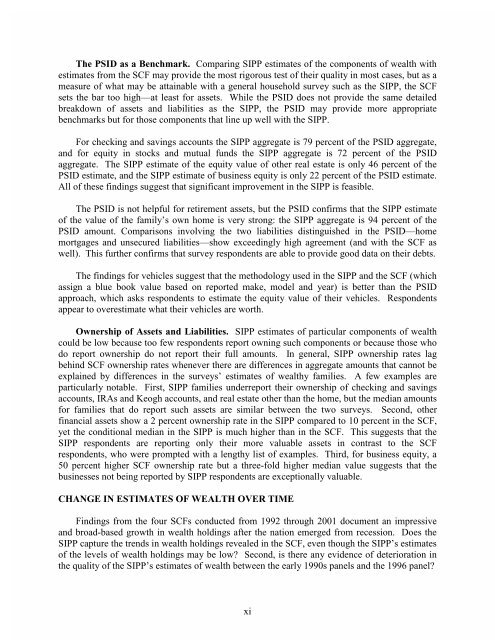Survey Estimates of Wealth - Mathematica Policy Research
Survey Estimates of Wealth - Mathematica Policy Research
Survey Estimates of Wealth - Mathematica Policy Research
You also want an ePaper? Increase the reach of your titles
YUMPU automatically turns print PDFs into web optimized ePapers that Google loves.
The PSID as a Benchmark. Comparing SIPP estimates <strong>of</strong> the components <strong>of</strong> wealth with<br />
estimates from the SCF may provide the most rigorous test <strong>of</strong> their quality in most cases, but as a<br />
measure <strong>of</strong> what may be attainable with a general household survey such as the SIPP, the SCF<br />
sets the bar too high—at least for assets. While the PSID does not provide the same detailed<br />
breakdown <strong>of</strong> assets and liabilities as the SIPP, the PSID may provide more appropriate<br />
benchmarks but for those components that line up well with the SIPP.<br />
For checking and savings accounts the SIPP aggregate is 79 percent <strong>of</strong> the PSID aggregate,<br />
and for equity in stocks and mutual funds the SIPP aggregate is 72 percent <strong>of</strong> the PSID<br />
aggregate. The SIPP estimate <strong>of</strong> the equity value <strong>of</strong> other real estate is only 46 percent <strong>of</strong> the<br />
PSID estimate, and the SIPP estimate <strong>of</strong> business equity is only 22 percent <strong>of</strong> the PSID estimate.<br />
All <strong>of</strong> these findings suggest that significant improvement in the SIPP is feasible.<br />
The PSID is not helpful for retirement assets, but the PSID confirms that the SIPP estimate<br />
<strong>of</strong> the value <strong>of</strong> the family’s own home is very strong: the SIPP aggregate is 94 percent <strong>of</strong> the<br />
PSID amount. Comparisons involving the two liabilities distinguished in the PSID—home<br />
mortgages and unsecured liabilities—show exceedingly high agreement (and with the SCF as<br />
well). This further confirms that survey respondents are able to provide good data on their debts.<br />
The findings for vehicles suggest that the methodology used in the SIPP and the SCF (which<br />
assign a blue book value based on reported make, model and year) is better than the PSID<br />
approach, which asks respondents to estimate the equity value <strong>of</strong> their vehicles. Respondents<br />
appear to overestimate what their vehicles are worth.<br />
Ownership <strong>of</strong> Assets and Liabilities. SIPP estimates <strong>of</strong> particular components <strong>of</strong> wealth<br />
could be low because too few respondents report owning such components or because those who<br />
do report ownership do not report their full amounts. In general, SIPP ownership rates lag<br />
behind SCF ownership rates whenever there are differences in aggregate amounts that cannot be<br />
explained by differences in the surveys’ estimates <strong>of</strong> wealthy families. A few examples are<br />
particularly notable. First, SIPP families underreport their ownership <strong>of</strong> checking and savings<br />
accounts, IRAs and Keogh accounts, and real estate other than the home, but the median amounts<br />
for families that do report such assets are similar between the two surveys. Second, other<br />
financial assets show a 2 percent ownership rate in the SIPP compared to 10 percent in the SCF,<br />
yet the conditional median in the SIPP is much higher than in the SCF. This suggests that the<br />
SIPP respondents are reporting only their more valuable assets in contrast to the SCF<br />
respondents, who were prompted with a lengthy list <strong>of</strong> examples. Third, for business equity, a<br />
50 percent higher SCF ownership rate but a three-fold higher median value suggests that the<br />
businesses not being reported by SIPP respondents are exceptionally valuable.<br />
CHANGE IN ESTIMATES OF WEALTH OVER TIME<br />
Findings from the four SCFs conducted from 1992 through 2001 document an impressive<br />
and broad-based growth in wealth holdings after the nation emerged from recession. Does the<br />
SIPP capture the trends in wealth holdings revealed in the SCF, even though the SIPP’s estimates<br />
<strong>of</strong> the levels <strong>of</strong> wealth holdings may be low? Second, is there any evidence <strong>of</strong> deterioration in<br />
the quality <strong>of</strong> the SIPP’s estimates <strong>of</strong> wealth between the early 1990s panels and the 1996 panel?<br />
xi
















